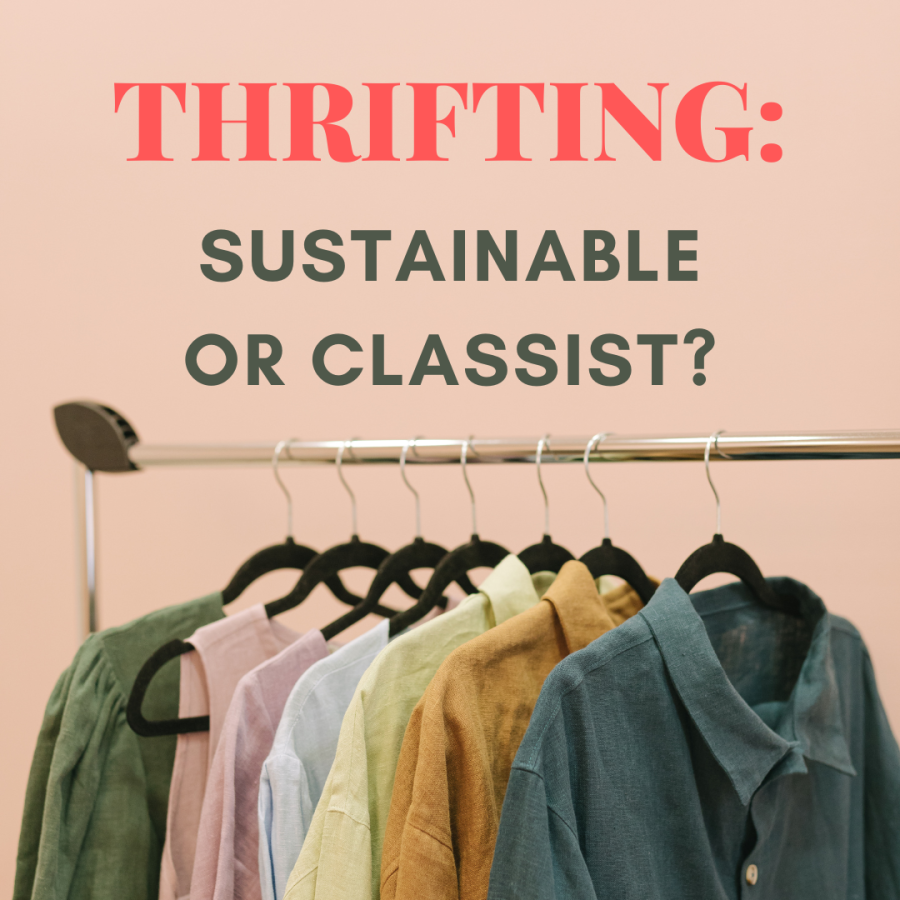Thrifting: Sustainable or Classist?
Is using thrifting as an alternative to buying new clothes good for the environment, or does it take away low-priced clothing from underprivileged communities?
November 18, 2022
What Is Thrifting?
The term “thrifting” was coined by modern-day Americans as a shortened version of “thrift shopping”, a kind of consumerism that has been steadily increasing in popularity over the past few years. Thrift stores (or thrift shops) are retail establishments run by charitable organizations to raise money, selling used goods such as clothing, books, shoes, toys, and furniture that are donated by members of the community. Since the items for sale are obtained for free, and the primary mode of staffing these stores is through volunteers, business costs are low and items can be sold at very inexpensive prices. After all the business costs are paid, the remaining profit from the store’s sales is used for the organization’s charitable purpose. Some well-known examples of nonprofits with chain thrift stores are Goodwill and The Salvation Army.
The way in which these stores operate is attractive to shoppers who are looking to give back to the community and be more environmentally friendly. Those who partake in thrifting can feel like the money they spend is going to a good cause, and can feel like they’re reducing waste through shopping for second-hand items that would otherwise go in a landfill. Other shoppers are partial to thrifting for budgetary reasons, as the goods (that are often only lightly used) are sold at impressively low prices. For this reason, these thrift stores can be a great resource for people looking to save, as well as for those in lower-income households. Some take advantage of these low prices for monetary gain, by buying a bunch of select items from their local thrift stores and reselling them online for triple, sometimes quadruple the price they bought them. These are all reasons we’ve seen thrifted clothes becoming a staple in modern fashion.
Fast Fashion and Overconsumption
Many people thrift to avoid the consumption of fast fashion. Fast fashion is a term used to describe a common business model in the clothing industry that entails replicating recent trends, mass-producing them at a low cost, and bringing them to retail stores quickly while demand is at its highest. This method of clothing production has proved to be both environmentally harmful and unethical. Companies that employ these practices rely greatly on low-cost labor from apparel manufacturers in different parts of Asia, where women amount to 85-90% of the garment production workforce. Labor practices in these countries are often exploitative due to loose labor laws, and because of this, these workers suffer from dangerous working conditions, low pay, discrimination, long hours, etc. Clothing companies based around fast fashion often choose these countries to manufacture their products knowing that the cost of labor is cheap, despite how the workers are treated. Some believe that by buying fast fashion, you are directly contributing to the mistreatment of these people, hence why many are turning to second-hand clothing alternatives such as thrifting.
In terms of fast fashion’s impact on the environment, Wikipedia’s page on fast fashion reads: “The global fashion industry is responsible for ~8–10% of global carbon emissions per year, to which fast fashion is a large contributor. The low cost of production favoring synthetic materials, chemicals, and minimal pollution abatement measures have led to excess waste.” As can be assumed, the more you consume products made in alignment with fast fashion practices, the more you are supporting these clothing companies’ ability to profit off of polluting our air and waterways with toxic chemicals. Many people turn to thrifting for this sole reason, so as to reduce their own personal carbon footprint and to instead support a charity that is selling clothes in a more sustainable way.
Another issue that piggybacks off of fast fashion is the overconsumption thereof, and clothing in general. This is largely due to fashion trends and the societal pressure that people feel to adhere to them. Many are willing to spend money on new, cheaper clothes every couple of months that are trendy but low quality and don’t last very long, rather than spend more money less often on timeless, ethically made, long-lasting, and good quality clothes. This common preference leads to consumers buying more clothes than they need, creating a lot of closet turnover. If consumers are going through clothes this quickly, more clothes are getting donated to thrift stores more often. Not all of these donated clothes are repurchased, which leads to an increased amount of clothing that goes into landfills. This amount of ‘clothing waste’ is yet another negative impact of fast fashion on the environment that thrifting cannot even fully combat due to overconsumption. This vicious cycle of corrupt capitalistic profit-making leaves the earth polluted, workers mistreated, unethical companies more powerful, and consumers poorer. This is just part of the reason why many consumers would rather thrift than contribute to this system.
Sustainability of Thrifting
Many individuals have made thrifting a component of their own personal sustainable initiatives by replacing much (if not all) of their shopping for new clothes with thrifting. In the article “How Thrift Shopping Is Being Kind To The Earth” it reads: “Thrift shopping is an overlooked way of practicing sustainability. This type of shopping reduces energy consumption, air pollution, mountains of landfill, and keeps our oceans cleaner.” It also outlines the issue of clothing waste that thrifting helps to combat: “An average American throws out 60-80 pounds of used clothing in a lifetime. Choosing to go thrift shopping reduces waste significantly, since fewer clothes will need to be produced. Less clothing means fewer textiles and fabrics will end up in enormous piles in a landfill.” While these reasons have compelled many to employ thrifting as an alternative to traditional clothes shopping, thrift stores are still no match for the amount of waste clothing production yields. “While you may donate your old clothing to charity…a whopping 84 percent of our clothing ends up in landfills and incinerators, according to the EPA.” states an article by Reader’s Digest. This statistic, while staggering, should not serve as a means of discouragement from sustainable practices. It should motivate us to thrift in place of purchasing new items more often so that we can hopefully bring this number lower.
Reselling: Are Clothes Being Taken from Those in Need?
Some people use thrifting as a way to make money. Online clothing marketplaces such as Depop and Poshmark are platforms designed for individuals to buy and sell used clothes, which to the naked eye, seems like online thrifting. It is in the sense that used clothes are being purchased, but that’s about it. The companies that run these websites are for-profit, and take a percentage out of every sale that occurs on their site. Those that sell their clothing on the site also earn the remaining money from their sales, so no money is going to charity. Clothes on these sites are also often sold for way more expensive than they would be in a thrift store, sometimes even more expensive than what the item was first purchased for when it was new.
These sites were made with the intent for users to sell clothes that they had 0wned and wanted to get rid of and buyers who wanted to buy a lower price item with the ease of online shopping. There has been a shift from using these online marketplaces for that system, to instead, sellers buying clothes from thrift stores in bulk and selling them for way more than they bought them for in order to turn a profit. These sellers handpick the best items from their local thrift store, sometimes alter them in some way, and then list them on sites like Depop and Poshmark, where they are purchased and then shipped out to the buyer. This “business” model has caused controversy online, with some arguing that it’s unethical to overconsume the best-quality clothes from a thrift store and sell them for triple the price for personal gain, as this takes away affordable clothing from underprivileged individuals. This argument has even gone as far as to say that people who are not in low-income financial situations should not be thrifting at all, as every piece of clothing they buy takes away from someone in need. These points have been countered by those who point out that there is more than enough clothing sold in thrift stores to go around, as most of it ends up in a landfill anyway. Sellers on these marketplace sites that alter and “thrift flip” clothes that they have bought from thrift stores argue that they are repurposing clothing that would otherwise not be sold, saving it from being wasted and allowing it to be worn in a new way by buyers. Reselling thrifted clothing has not yet gotten to a point where thrift stores are empty by the time the people who need them the most go to shop, but this could be a future concern. As we’ve seen with fast fashion, consumption can turn to overconsumption very quickly and create devastating consequences.
Should You Thrift?
Thrifting has become a trend, and this comes with its presumable benefits and drawbacks. More people are shopping for clothing sustainably in a way that funds charities, but if thrifting becomes too popular, this could lead to low-income households losing access to good quality and affordable clothing. Always do your research on the organization before shopping at one of its thrift stores, and be aware of how much of its profits go to charitable causes. A great local option would be Dorcas Thrift Shop in Cary. They have great donation, volunteering, and thrifting opportunities with proceeds going to education, food, gas/transportation, and housing for low-income individuals in our community.
We should remind ourselves that thrift stores exist largely due to the overconsumption of fast fashion in the first place, so when you’re thrifting, make sure you’re not over-consuming what is the product of overconsumption.







